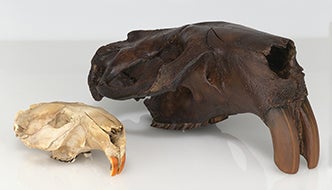 A few snippets of protein extracted from the fossil of an extinct species of giant beaver are opening a new door in paleoproteomics, the study of ancient proteins. Ancient proteins can be used to place animals on the evolutionary tree, and could offer insights into how life and Earth’s environment have evolved over time. Typically, paleoproteomics relies on fossils collected for the purpose. But in a paper published recently in the Proceedings of the Royal Society B, researchers at Rensselaer used a fossil collected more than 170 years ago in central New York.
A few snippets of protein extracted from the fossil of an extinct species of giant beaver are opening a new door in paleoproteomics, the study of ancient proteins. Ancient proteins can be used to place animals on the evolutionary tree, and could offer insights into how life and Earth’s environment have evolved over time. Typically, paleoproteomics relies on fossils collected for the purpose. But in a paper published recently in the Proceedings of the Royal Society B, researchers at Rensselaer used a fossil collected more than 170 years ago in central New York.
“Paleoproteomics is a young field. We don’t yet know the full potential of the information it may offer us, and one barrier to that is the supply of fossils we can call upon for research,” said Deepak Vashishth, professor of biomedical engineering and director of the Center for Biotechnology and Interdisciplinary Studies. “In developing these techniques, we’re creating new value in fossils that are already on exhibit, or sitting in storage waiting for a purpose.”
The team of researchers extracted proteins from the first skull of the species Castoroides ohioensis ever found. Collected in 1845, the giant beaver skull, housed at the New York State Museum, is the oldest museum-curated bony specimen to have been studied using paleoproteomic tools. The researchers were searching for proteins, chains of amino acids assembled from instructions encoded in DNA that perform a wide variety of functions in living organisms. Using mass spectrometry analysis, researchers detected many samples of collagen 1, the most common protein in bone.
The big challenge to drawing upon existing fossil collections is that they weren’t collected for the purpose of paleoproteomics, and they may not have been stored in conditions optimal to protein extraction and analysis techniques.
When researchers studied the giant beaver skull, the first thing they noticed was that it appeared to have varnish, a common treatment used to preserve fossils, applied to the outside of it. To avoid the varnish (which is itself organically based), they took samples from the nasal cavities of the skull. They removed a small sample of bone, extracted the preserved proteins, digested with enzyme, and analyzed the protein pieces with mass spectrometry.
The analysis determined the primary sequence of amino acids in the protein detected, as well as post-translational modifications, chemical changes on the surface of the protein that are not defined by DNA.
A database of primary protein sequences could be useful in clarifying evolutionary trees, in reverse engineering proteins to understand how particular proteins evolved over a period of time, or in “reviving” a sequence that may be nonexistent now for therapeutic use.


